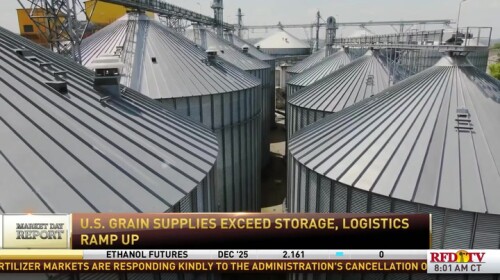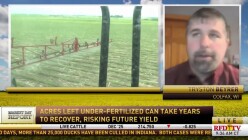Corn
Pressure on grain storage capacity and stronger export positioning are pushing more grain onto railroads, highways, and river systems as logistics become a key bottleneck this fall.
With the U.S.–Vietnam agreement nearing signature, U.S. cotton, corn, and soybean exporters could lock in new demand lanes just as global supply shifts.
Friday’s release will be the first WASDE report in about two months, and early estimates indicate a corn surplus is still on the way.
Export strength is concentrated in corn and wheat, while soybeans and sorghum lag, keeping basis and logistics dynamics highly commodity-specific into late fall.
Ohio AgNet’s Dusty Sonnenberg takes us up in the cab with a popcorn farmer bringing in this year’s haul.
Record output, larger stocks, and softer exports point to a well-supplied domestic ethanol market as harvest progresses.
David Klein with the American Society of Farm Managers and Rural Appraisers (ASFMRA) shares an end-of-harvest update and a peek at the farmland market in Central Illinois.
A strong corn export pull is supportive of bids; soybeans need steady vessel programs or fresh sales to firm cash.
China’s grain expansion model may be hitting its limit. Lower prices, high rents, and policy fatigue threaten future output — with ripple effects across global feed and oilseed markets.
Market analyst and friend of the show, Shawn Hackett, says Brazil’s shifting use of crops for biofuel production is a significant factor.
Farm CPA Paul Neiffer joined us on Thursday’s Market Day Report to discuss the implications for farmers.
Rich Nelson, a commodity broker for Allendale Inc., joins us to break down what the U.S.-China trade agreement means for the ag economy.
The U.S.-China summit raises hopes for stronger exports and reduced barriers, but U.S. ag players should remain strategically cautious until concrete volumes and certifications materialize.
Expect incremental near-term lift for feed grains, proteins, and ethanol as tariff cuts and smoother approvals translate into real orders.
Export volumes remain positive year-to-date, but weaker soybean loadings and slowing wheat movement hint at early bottlenecks in global demand or river logistics. Farmers should watch basis levels and freight conditions as export competition heats up.
Industry leaders representing more than 40 nations gathered to discuss the future of ethanol and other corn-based products.
A fast-moving series of trade signals from the White House and key partners is resetting the near-term outlook for U.S. agriculture.
Margin Protection and the new MCO add county-level margin tools — with earlier price discovery, input cost triggers, and high subsidy rates — to complement on-farm risk plans for 2026.
Set targets and use forwards, futures, or options to manage downside while preserving room for rallies.
Expanding bioethanol use strengthens rural economies, supports farm markets, and positions U.S. agriculture at the center of global low-carbon trade.
Corn and wheat inspections outpaced last year, but soybean movement remains seasonally active yet behind, keeping basis and freight dynamics in focus by corridor.
In the meantime, Senate Majority Leader John Thune is asking that farmers be allowed to use marketing assistance loans to help stay afloat.
This high-yield corn contest showcases real-life Corn Warriors dealing with elements that every farmer knows well. Get an authentic look at what it takes to compete in a high-yield corn contest, and see who will take the title of Corn King.
























